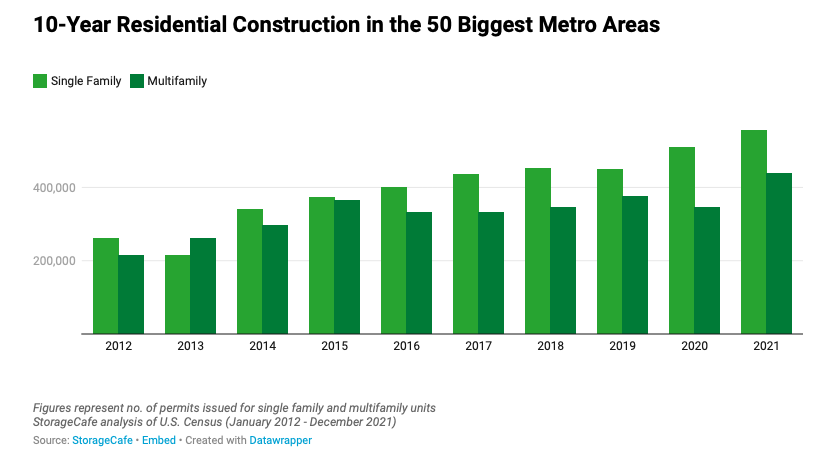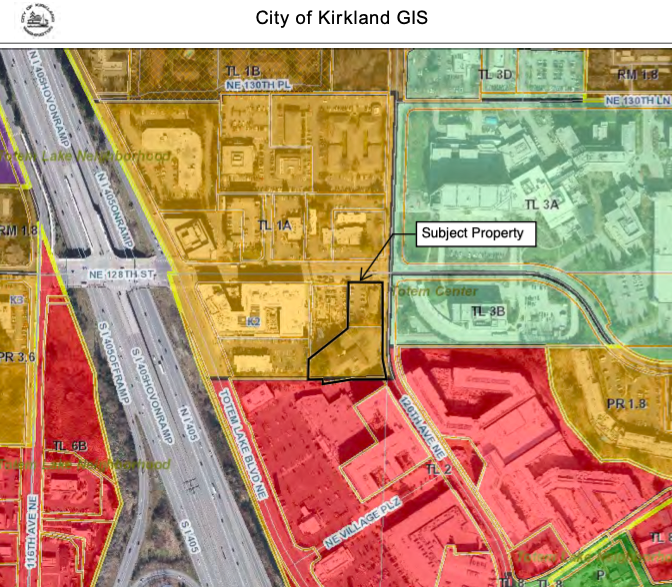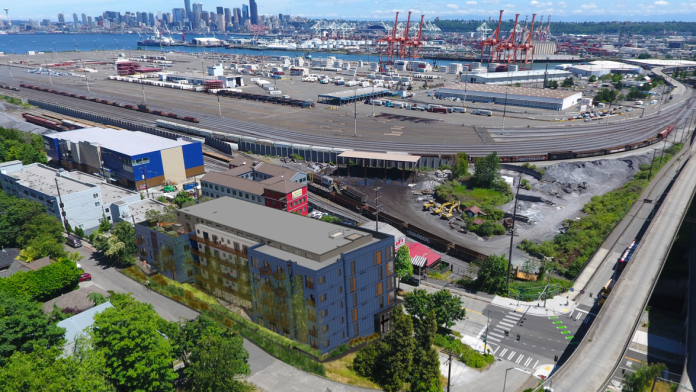
The Puget Sound Regional Council adopted a Regional Housing Strategy which could have a big impact on housing growth — if cities and counties follow through.
In this installment of housing notes, the Seattle metro region emerges as a nationwide leader in building multi-family housing, the Puget Sound Regional Council adopts a housing strategy, plans for middle-income housing advance in West Seattle, a 16-story Totem Lake mixed-use project with 300 homes goes to design review in Kirkland, and public engagement is solicited on design standards for North Highline (White Center, Top Hat, South Park).
Seattle ranks 12th in most active US real estate markets over the last decade
A recent study released by StorageCafé found that the Seattle metro region ranked as the 12th most active real estate market in the United States during the last decade. The Seattle metropolitan area is ranked the 13th largest metropolitan area by population, according to the Census Bureau, so it’s punching slightly above its weight. To assign its rankings, the study assessed the number of housing permits issued and square feet of commercial, industrial, and retail space added. Here are a few Seattle metro area highlights from the study:
- Nearly 157,000 multifamily building permits were issued, ranking fifth in the nation in multifamily development behind New York, Dallas, Los Angeles, and Houston. That’s more than double the number of permits issued in the Portland metro area, where about 70,000 multifamily permits were issued in the last decade.
- By comparison, the Seattle region issued 89,000 building permits for single-family construction, which ranked 17th in the nation.
- 29.6 million square feet of office space was built — to put that in context, Los Angeles added about 31 million square feet of office space despite being about a 3.3 times larger metro area than Seattle.
It’s important to point out that while multifamily building permits led the way in the Seattle metro area, the same cannot be said of the U.S. as a whole. The last time more multifamily than single-family buildings were permitted was in 2013, a year that appears as an outlier in a decade in which single-family buildings remained dominant, a trend that has become even more pronounced since 2017, with a slight reduction in 2021.
While the Seattle metro area has not succeeded in producing enough housing to keep pace with population and job growth, it is encouraging to see that it is bucking the national trend of single-family dwellings dominating residential construction. However, relying less on single-family urban sprawl than other regions do means the Seattle area must produce multifamily housing at a greater pace than it does. Washington State has fewest number of housing units per household of any state in the country, and it’s really starting to show and our housing crisis spirals.
The following housing stories help to explain and illustrate how our region is forging a different path for homes.
PRSC adopts Regional Housing Strategy
The Puget Sound Regional Council (PSRC) has officially adopted a Regional Housing Strategy that had been released as a draft last year. The Urbanist’s Shaun Kuo reported on how the agency hoped to “galvanize [the] region into action” with its proposed strategy during summer of 2021. To inform its work on the plan, PRSC conducted a Housing Needs Assessment, which found that Puget Sound region needs to add approximately 810,000 homes by 2050, and that it can expect over a third of them (34%) will need to be affordable to moderate and lower-income households.
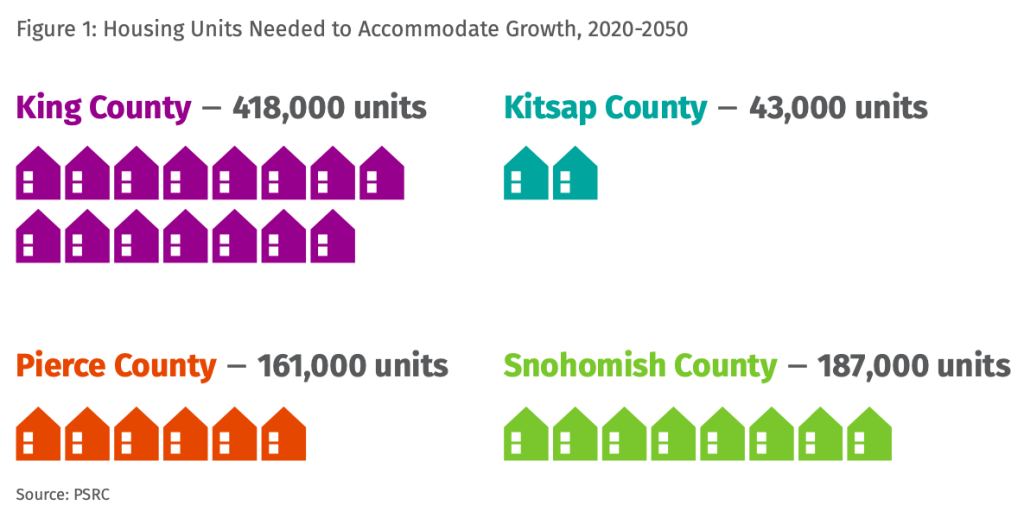
At present, when only taking population growth into account, PRSC estimates that the region is about 46,000 homes short. Taken all together, the numbers are dizzying, which is why PSRC is calling for bolder action. In their Housing Strategy they outline a series of goals and measures intended to take on the crisis. Here’s an overview what they are calling for.
- Increasing housing supply by building more housing of different types
- Allow for more moderate and denser housing near transit to meet the goal of having 65% of residential growth in the Puget Sound region be located near high-capacity transit stations.
- Zone for moderate density “missing middle” housing to increase opportunities for townhomes and multiple units in neighborhoods with infrastructure, services, and amenities. Moderate density housing can fit well within established neighborhoods and significantly increasing housing supply and choices for households at 80-120% area median income (AMI).
- Reform single-family zoning to increase opportunities for small lots, zero-lot line, accessory dwelling units, cottage homes, and up to six units per lot that serve a wider range of households, including singles, couples, seniors, and smaller families.
- Reduce the costs to build housing by increasing densities, reducing minimum lot sizes, and reducing or eliminating parking requirements; increasing development predictability; and invest in education for trades people and new building technologies.
- Providing opportunities for people to live in housing that meets their needs
- Expand and strengthen tenant assistance and protections, and their enforcement to provide opportunities for residents to continue to live in their communities.
- Advocate for a bill to support equitable home ownership assistance that expands home ownership and down payment assistance programs to provide support for renters seeking to purchase a home in their community.
- Increase services and amenities like childcare and healthcare centers to provide access to opportunity in low opportunity areas experiencing housing growth.
- Use voluntary and/or mandatory incentives to include affordable housing in all new development in proximity to transit and in higher opportunity areas.
- Adopt Multifamily Tax Exemption (MFTE) in all areas near frequent transit where allowed under state law. PSRC’s survey of local jurisdictions showed MFTE to be the most effective tool at creating more housing and housing units at moderate-income levels.
- Creating and sustaining long-term funding sources to create and preserve housing for very low-income households and unhoused residents
- Identify public, private, and philanthropic funding to increase affordable housing and access to housing for lower-income families.
- Advocate for substantial federal and state funding to address affordability for very low-income households.
- Encourage major employers to finance affordable housing construction and preservation to provide opportunities for employees to live closer to where they work.
- Expand local funding options and how they are used across the region.
Many of these actions have been advocated for by pro-housing activists for some time and it is encouraging to see PRSC officially adopt them as guiding policies. What will really matter, however, is how these policies become implemented, and in terms of implementation, PSRC itself acknowledges that “[m]any of the needed actions require work by cities and counties as zoning and permitting are local functions.”
PSRC does not have the regulatory authority to enforce the actions of the Regional Housing Strategy and will instead need to rely on incentives to coax its jurisdictions to undertake the policy changes it is advocating for. Expanding the technical assistance it can provide to cities and counties interested in taking action, creating regional funding programs, and identifying opportunities for funding from the federal government and private partners are all named as possibilities for implementation. Still there appears to be a disconnect between what the PSRC is seeking and what even cities like Seattle are willing to take on, meaning that either attitudes will need to change, or incentives will need to become very appealing, for this ambitious regional housing strategy to become reality.
Middle-income housing development planned in West Seattle
The Housing Diversity Corporation (HDC), which describes itself as “a housing innovator dedicated to providing a forward-thinking alternative to traditional apartment living in urban centers,” recently announced that it received a $25.76 million dollar loan that will enable them to proceed ahead with plans to build a 114 home apartment development in West Seattle near the West Seattle Bridge.
Located at 3405 Harbor Avenue, the development is proposed to include 91 attainably priced market-rate units and 23 home made affordable through the City’s Multifamily Tax Exemption (MFTE) Program. 65 parking stalls have been proposed as part of the development.
The lot on which the development will be constructed is sloped, requiring a variety of technical considerations in regards to the design of the building and it landscaping. Currently the land is undeveloped.
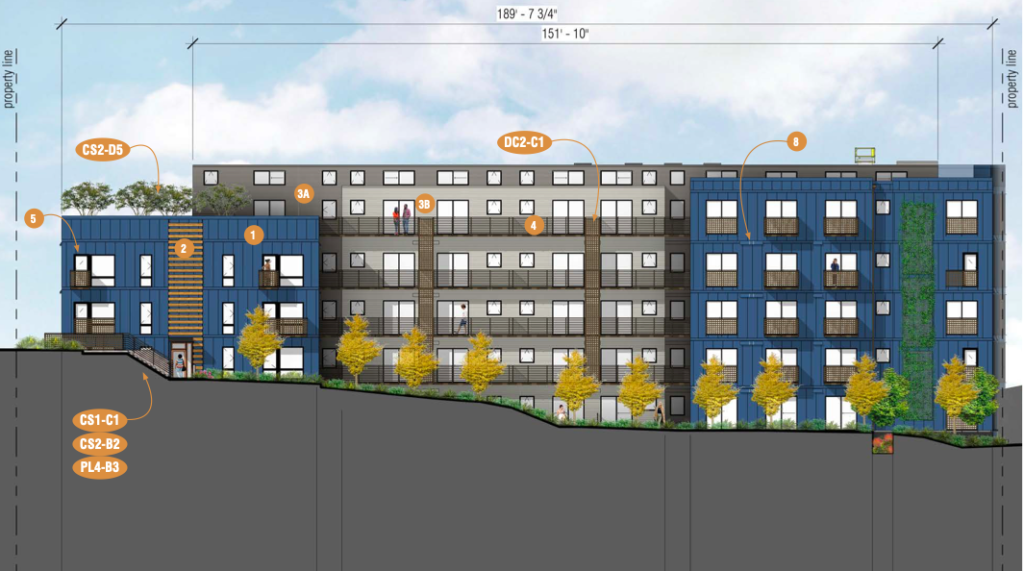
This project is the latest in a series of developments that have been undertaken or are currently in the works by HDC across Seattle. A review of the completed developments in HDC’s current shows a tendency to build micro-flats, compact studios, and one-bedroom apartments, in dense urban areas. For example, an apartment building on 12th Street in Capitol Hill built by HDC rents out 250 square foot apartments for approximately $1,100 per month. According to RentCafé, the average studio cost in Capitol Hill is over $1,500 per month, making HDC’s building a deal for the neighborhood. It should also be noted that current design review documents filed with the City do not describe the size of the proposed West Seattle homes, but HDC does seem to expanding out from the micro flat model as it takes on more projects. That model could get a boost; Mayor Bruce Harrell has floated the idea of relaxing restrictions to encourage more micro-housing.
HDC has an impressive array of developments with similar affordability aims in the works across Seattle, including 398 home development at 900 and 912 Rainier Avenue S, 242 homes at 701 S Jackson Street, and 271 homes 7324 Martin Luther King Jr Way S, among other projects. As in West Seattle, all of their projects in the pipeline are aimed to create housing affordable for people at moderate and low-incomes. HDC also has completed buildings in Los Angeles and plan to expand across the West Coast.
16-story, 300-unit mixed-use development in Kirkland
Rising 16-stories, the proposed development by Gensler and MainStreet would be the tallest building in Kirkland if built — at least until the 300-foot rezone around I-405 and 85th Street bears fruit. Located near the Totem Lake Transit Center, which will be eventually served by King County Metro’s RapidRide K Line, the development plans to offer 300 homes and ground-level commercial space.
At a March 7th design review meeting, the developer and architects shared their proposed alternatives for the site, including a preferred alternative featuring an L-shaped design and the tallest tower option. The mega-block size of the lot shows in the long massing, but the architects appear to have done a good job defining each end of the building. The 16-story tower rising along NE 128th Avenue, the slightly offset massing at the opposite end, and the bridge podium between the two creates distinct segments and visual interest.
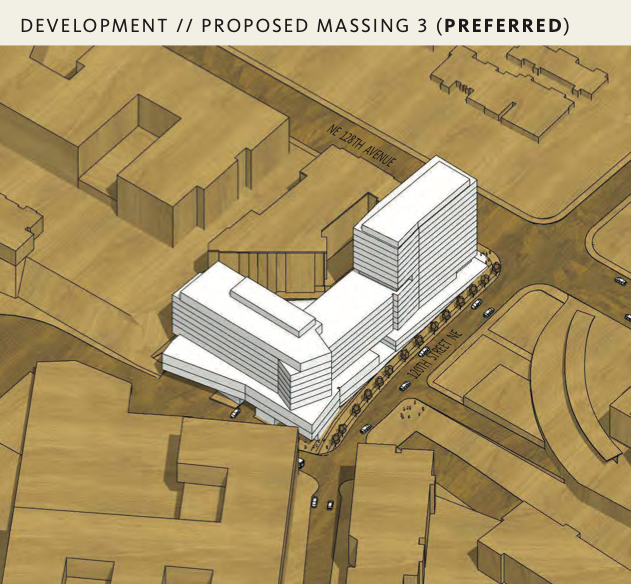
Although still a sprawling mall and parking crater now, the area around the Totem Lake transit center is poised to become one of the densest neighborhoods in Kirkland in upcoming years. Earlier this year, American Capital Group announced plans for a five-story residential and retail development on a 4.53 acre property located at 12700 and 12704 NE 124th Street in Kirkland at the beginning of the year. According to the developers, it will include 493 homes, 20% of which will be priced as workforce housing, and more than 11,000 square feet of ground floor retail.
The influx of homes are welcome additions to a transit-rich area struggling with skyrocketing housing prices. Kirkland single-family homes now go for $1.4 million on average, according to Zillow.
Public input sought on North Highline urban design standards and guidelines
The King County Council (KCC) has directed the County’s Local Services division to undertake the creation of urban design standards for North Highline, a 2.7 square mile urban area in unincorporated King County that includes the communities of White Center, Top Hat, Glendale, and the South Park “Sliver by the River.” KCC has requested that the urban design standards “prioritize the pedestrian environment, encourage human-scale design, and reflect the character of the North Highline community.”
To ensure the standards reflect the community’s values and goals, public engagement is encouraged. A draft of the plan is available to review online and email comments can be submitted to subareaplanning@kingcounty.gov. Make sure that the subject line contains “North Highline Design Standards.”
Also, a Zoom event will be held on March 18th from 12pm to 1pm. Comments on the proposed North Highline urban design standards will be open through March 28th.
Natalie Bicknell Argerious (she/her) is a reporter and podcast host at The Urbanist. She previously served as managing editor. A passionate urban explorer since childhood, she loves learning how to make cities more inclusive, vibrant, and environmentally resilient. You can often find her wandering around Seattle's Central District and Capitol Hill with her dogs and cat. Email her at natalie [at] theurbanist [dot] org.

